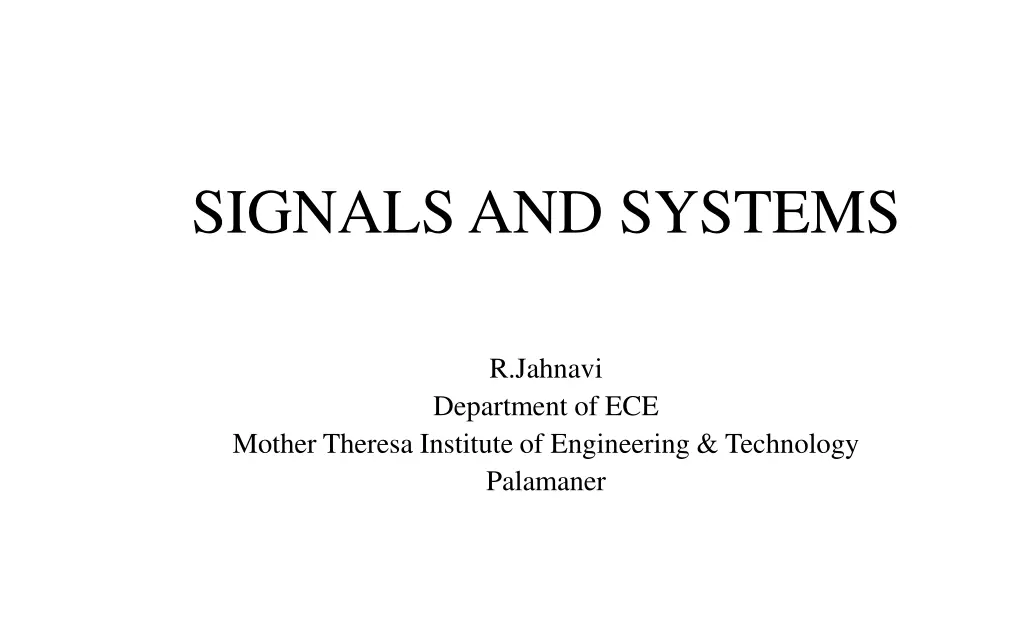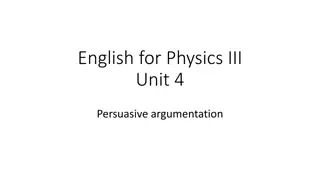
Understanding Signals and Systems in ECE at MTIET Palamaner
Explore the concepts of signals and systems as R. Jahnavi from the Department of ECE at Mother Theresa Institute of Engineering & Technology, Palamaner delves into topics such as system types, causality, linearity, and time variance. Learn about the classification and characteristics of various systems in the field of engineering.
Download Presentation

Please find below an Image/Link to download the presentation.
The content on the website is provided AS IS for your information and personal use only. It may not be sold, licensed, or shared on other websites without obtaining consent from the author. If you encounter any issues during the download, it is possible that the publisher has removed the file from their server.
You are allowed to download the files provided on this website for personal or commercial use, subject to the condition that they are used lawfully. All files are the property of their respective owners.
The content on the website is provided AS IS for your information and personal use only. It may not be sold, licensed, or shared on other websites without obtaining consent from the author.
E N D
Presentation Transcript
SIGNALS AND SYSTEMS R.Jahnavi Department of ECE Mother Theresa Institute of Engineering & Technology Palamaner
UNIT -III SIGNAL TRANSMISSION THROUGH LINEAR SYSTEMS
What is System? Systems process input signals to produce output signals A system is combination manipulates one or more signals to accomplish a function and produces some output. system of elements that output signal input signal
Types of Systems Causal & Anti-causal Linear & Non Linear Time Variant &Time-invariant Stable & Unstable Static & Dynamic Invertible & Inverse Systems
Causal & Anti-causal Systems Causal system : A system is said to be causal if the present value of the output signal depends only on the present and/or past values of the input signal. Example: y[n]=x[n]+1/2x[n-1]
Causal & Anti-causal Systems Contd. Anti-causal system : A system is said to be anti- causal if the present value of the output signal depends only on the future values of the input signal.
LinearSystems Linear System: A system is linear if and only if and = T { x [ n ] + x [ n ]} = T x [ n ] + T x [ n ] (additivit y) 1 2 1 2 (scaling) ] n [ x T ax [ n ] aT y [ n ] = x [ n n ] o Example: Ideal Delay System ] n [ x { T 1 + + x [ n ]} = x [ n n ] + x [ n n ] 2 1 o 2 o T { x [ n ]} T x [ n ] = x [ n n ] + x [ n n ] 2 1 1 o 2 o T ax [ n ] = ax [ n n ] 1 o aT x [ n ] = ax [ n n ] 1 o
Time Invariant and Time Variant Systems A system is said to be time invariant if a time delay or time advance of the input signal leads to a identical time shift in the output signal. ( ) { ( { { ( )}} H S x t = = )} HS y t H x t t 0 = i 0 0 t t { ( )} x t = 0 t ( ) S { ( )} y t y t = S 0 = 0 0 t t { { ( )}} H x t { ( )} S H x t
Stable & Unstable Systems A system is said to be bounded-input bounded- output stable (BIBO stable) iff every bounded input results in a bounded output. i.e. | ( )| x t x t M | ( )| y t t M y
Static & Dynamic Systems A static system is memoryless system It has no storage devices its output signal depends on present values of the input signal For example
Static & Dynamic Systems Contd. A dynamic system possesses memory It has the storage devices A system is said to possess memory if its output signal depends on past values and future values of the input signal
CONTINUOUS TIME SYSTEM A continuous time system (or Analog system) is a physical device that operates on a continuous time signal called input or excitation, according to some well defined rule, to produce another continuous time signal called output or response. The input signal x(t) is transformed by the system into a signal y(t) . Diagrammatic representation of continuous time system Response , y(t) = H{x(t)} Where, H denotes the transformation (also called an operator). x(t) y(t) H Input signal or Excitation Output signal or Response Continuous time system
CONTINUOUS TIME SYSTEM A continuous time system (or Analog system) is a physical device that operates on a continuous time signal called input or excitation, according to some well defined rule, to produce another continuous time signal called output or response. The input signal x(t) is transformed by the system into a signal y(t) . Diagrammatic representation of continuous time system Response , y(t) = H{x(t)} Where, H denotes the transformation (also called an operator). x(t) y(t) H Input signal or Excitation Output signal or Response Continuous time system
LTI SYSTEM A continuous time system is linear if it obeys the principle of superposition and it is time invarient if its input-output relationship does not change with time. When a continuous time system satisfies the properties of linearity and time invarience then it is called as LTI system. IMPULSE RESPONSE: Impulse response , h(t) = H{ (t)} (t) h(t) H Input signal or Excitation Output signal or Response Continuous time system
RESPONSE OF LTI-CT SYSTEM IN TIME DOMAIN The general equation governing an LTI continuous time system is, The solution of the differential equation is the response y(t) of the LTI system, which consists of two parts. In mathematic, the two parts of the solution y(t) are the homogeneous solution yh(t) and the particular solution yp(t). Response, y(t) = yh(t)+yp(t)
CONT The homogenous solutionis the response of the system where there is no input. The particular solutionyp(t) is the solution of difference equation for specific input signal x(t) for t 0. In signal and systems the two parts of the solution y(t) are called zero-input response yzi(t) and zero-state response yzs(t). Response, y(t) = yzi(t)+yzs(t) The zero input response is given by the homogenous solution with constant evaluated using initial values of output (or initial condition).
CONT The zero-input response is mainly due to initial output conditions (or initial stored energy) in the system. Hence the zero-input response is also called free response or natural response. The zero-state response is given by the sum of homogeneous solution and particular solution with zero initial conditions. The zero-state response is the response of the system due to input signal and with zero initial output condition. Hence the zero-state response is also called forced response.
TRANSFER FUNCTION OF LTI CT SYSTEM The transfer function of a continuous time system is defined as the ratio of Laplace transform of output and Laplace transform of input. Let, x(t) = Input of a LTI continuous time system y(t) = Output / Response of the LTI continuous time system for the input x(t) h(t) = Impulse response (i.e., response for impulse input) ?(?) ?(?) ---- the transfer function of LTI continuous time system is also given H(s) = by Laplace transform of the impulse response. Inverse Laplace transform of transfer function is the impulse response of the system. ?(?) ?(?) Impulse response, h(t) = ? ?{?(?)} = ? ?
CONVOLUTION & DECONVOLUTION CONVOLUTION: The convolution operation is performed to find the response y(t) of LTI continuous time system from the input x(t) and the impulse response h(t). Response, y(t) = x(t) * h(t) On taking Laplace transform of the above equation we get, L {y(t)} = L{x(t)*h(t)} Y(s) = X(s) H(s) Response, y(t) = L-1{Y(s)} = L-1{X(s) H(s)}
CONT DECONVOLUTION: The deconvolution is the operation is performed to extract the input x(t) of an LTI continuous time system from the response y(t) of the system. We know that, X(s) = ?(?) ?(?) On taking inverse Laplace transform of the above equation we get, Input x(t) = L-1{X(s)} = L-1{?(?) ?(?)}
System Realization + + ... + 1 M M ... b s b s b = 0 1 ( ) M H s + + + 1 N N s a s a 1 N Realization is a synthesis problem, so there is no unique way of realizing a system. A common realization of H(s) is using Integrator Scalar multiplier Adders
Direct Form I Realization + + + 3 2 b s b s b s b = 0 s 1 s 2 s 3 ( ) H s + + + 3 2 a a a b b b 1 2 3 + + + b 3 1 2 0 2 3 s s s = Divide every term by s with the highest order s3 ( ) H s a a a + + + 1 3 1 2 2 3 s s s 1 b b b = + + + 3 ( ) 1 2 H s b 0 a a a 2 3 s s s + + + 1 3 1 2 2 3 s s s H1(s) H2(s) X(s) W(s) Y(s)
Direct Form I Realization H2(s) H1(s) X(s) W(s) Y(s) ( s 1 b b b = + + + ) 3 1 2 H b 0 a a a 2 3 s s s + + + 1 3 1 2 2 3 s s s
Direct Form II Realization H1(s) H2(s) X(s) W(s) Y(s) 1 b b b = + + + 3 ( ) 1 2 H s b 0 a a a 2 3 s s s + + + 1 3 1 2 2 3 s s s
Cascade and Parallel Realizations + 4 2 28 + s s = ( ) H s + 6 5 s Cascade Realization + )( + 4 28 s 4 28 1 s s = = ( ) H s + + + + ( 1 ) 5 1 5 s s s Parallel Realization + 4 + 28 s 6 + 2 + s = = ( ) H s ) 5 + ( 1 )( 1 5 s s s The complex poles in H(s) should be realized as a second-order system.
FOURIER TRANSFORM Analysis of LTI Continuous Time System Using Fourier Transform: Transfer Function of LTI CTS in Frequency Domain The ratio of Fourier transform of output and the Fourier Transform of input is called transfer function of LTI continuous time system in frequency domain. Let, x(t) = Input to the continuous time system y(t) = Output to the continuous time system X(j ) = Fourier transform of x(t) Y(j ) = Fourier transform of y(t) ?(j ) ?(j ) Now, Transfer function =
IMPULSE RESPONSE AND TRANSFER FUNCTION For a continuous time system H, if the input is impulse signal (t) then the output is called impulse response, which is denoted by h(t). (t) h(t) H The response for any input to LTI system is given by convolution of input and impulse response. Symbolically, the convolution operation is denoted as, y(t) = x(t) * h(t) * is the symbol of convolution. Mathematically, the convolution operation is defined as, y(t) = x(t) * h(t) = + ? ? ? ? ?? ? is the dummy variable for integration
Cont Now, by convolution property of Fourier transform we get, F{x(t) * h(t)} = X(j )H(j ) F{y(t)} = X(j )H(j ) Y(j ) = X(j )H(j ) H(j ) = Y(j ) X(j ) The transfer function in frequency domain is given by Fourier transform of impulse response. Note: only a forced response alone can be computed via frequency domain. Relation Between Fourier and Laplace Transform X(j ) = X(s)|s=j
PROBLEM Determine the convolution of x1(t) = e-2t u(t) and x2(t) = e-6t u(t), using fourier transform. Solution: Let X1(j ) = Fourier transform of x1(t) X2(j ) = Fourier transform of x2(t) By convolution property of Fourier transform F{x1(t) * x2(t)} = X1(j )X2(j ) Let X(j ) = X1(j )X2(j ) = F{e-2t u(t)} x F {e-6t u(t)} 1 j +2 x 1 = j +6
Cont By partial fraction expansion technique X(j ) can be expressed as, X(j ) = (j +2)(j +6) = K1 = (j +2)(j +6)x (j + 2)|j =-2 = K2 = (j +2)(j +6)x (j + 6)|j =-6 = 1 ?1 ?2 (j +2) + (j +6) 1 2+6 = 1 1 6+2 = -1 1 4 = 0.25 4=- 0.25 1 0.25 j +6 X(j ) = 0.25 j +2 - On taking inverse Fourier transform of the above equation we get, x(t) = 0.25e-2tu(t)-0.25e-6tu(t) = 0.25(e-2t-e-6t)u(t)
Problem 2 The impulse response of an LTI system is h(t) = 2e-3tu(t). Find the response of the system for the input x(t) = 2e-5tu(t), using Fourier transform. Solution Given that, x(t) = 2e-5tu(t) X(j ) = F{x(t)} = F{2e-5tu(t)} = j +5 Given that, h(t) = 2e-3tu(t) H(j ) = F{h(t)} = F{2e-3tu(t)} = j +3 For LTI system, the response, y(t) = x(t) * h(t) On taking Fourier transform of equation (3) we get, F{y(t)} = F{x(t)*h(t)} Let F{y(t)} = Y(j ) Y(j ) = F{x(t)*h(t)} = X(j )H(j ) = ? +5? (? +5)(? +3) 2 (1) 2 . (2) ..(3) 2 2 4 ? +3 =
Cont By partial fraction expansion technique X(j ) can be expressed as, Y(j ) = (j +5)(j +3) = K1 = (j +5)(j +3)x (j + 5)|j =-5 = -2 K2 = (j +5)(j +3)x (j + 3)|j =-3 = 2 1 ?1 ?2 (j +5) + (j +3) 1 1 2 2 Y(j ) = - j +5 + j +3 On taking inverse Fourier transform of the above equation we get, x(t) = -2e-5tu(t)+2e-3tu(t) = 2(e-3t-e-5t)u(t)






















